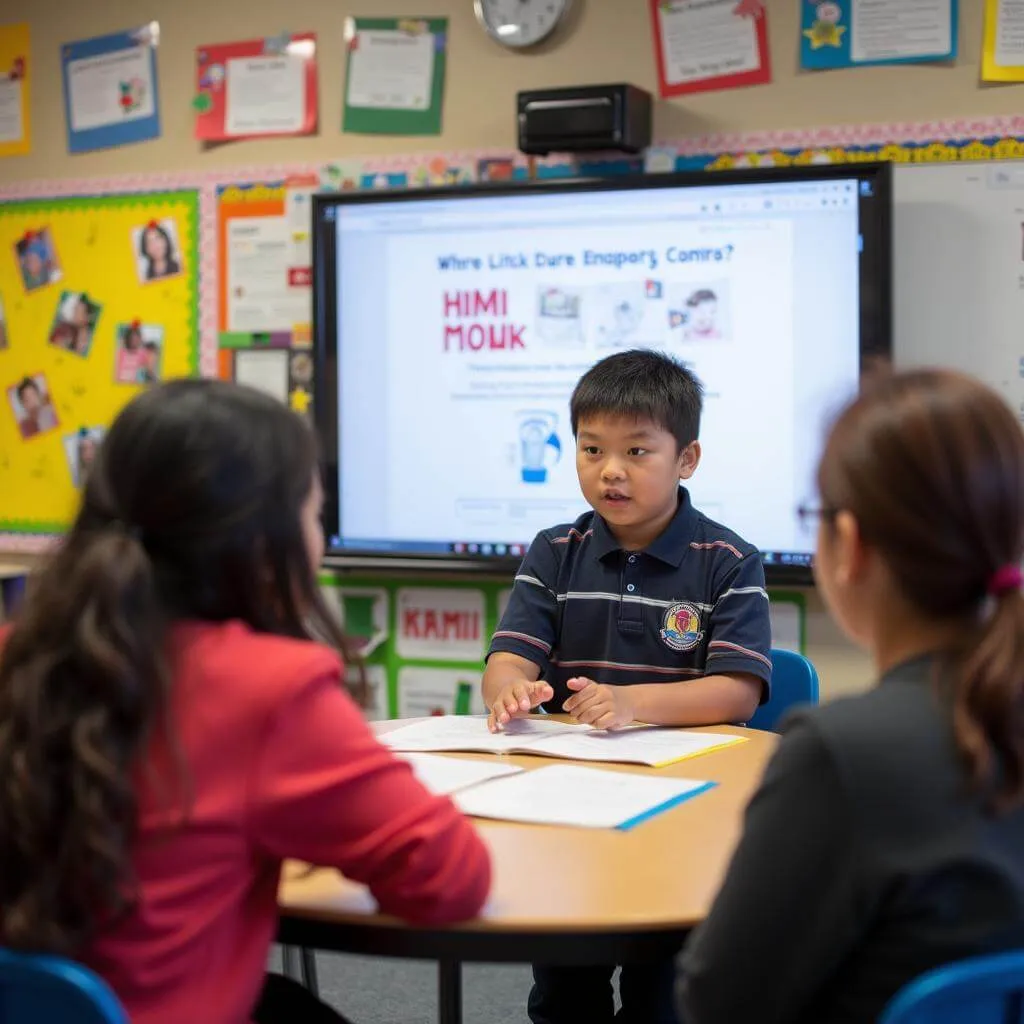IELTS Reading Practice Test: Cultural Diversity in Approaches to Student-Led Conferences
Passage 1 – Easy Text
Student-led conferences have become increasingly popular in educational settings worldwide. These conferences provide an opportunity for students to take ownership of their learning and communicate their progress to their parents or guardians. However, the approach to student-led conferences can vary significantly across different cultures, reflecting diverse values and educational philosophies.
In Western countries, such as the United States and United Kingdom, student-led conferences often emphasize individual achievement and personal growth. Students are encouraged to showcase their best work, reflect on their strengths and weaknesses, and set goals for future improvement. This approach aligns with the Western cultural emphasis on individualism and self-expression.
 Student-led conference in a Western classroom
Student-led conference in a Western classroom
Conversely, in many Asian countries, student-led conferences may focus more on collective achievement and group harmony. Students might be expected to discuss not only their personal progress but also how they contribute to their class or school community. This reflects the cultural value placed on collaboration and interdependence in many Asian societies.
Some cultures prioritize academic performance above all else in student-led conferences. In these contexts, students may be expected to present detailed academic reports, test scores, and rankings. This approach is common in countries with highly competitive education systems, where academic success is seen as crucial for future opportunities.
In contrast, other cultures take a more holistic approach to student-led conferences, emphasizing the development of the whole child. These conferences might include discussions about social-emotional growth, extracurricular activities, and character development alongside academic progress. This approach is often seen in educational systems that value a well-rounded education.
 Student-led conference with a focus on holistic development
Student-led conference with a focus on holistic development
The role of parents in student-led conferences also varies across cultures. In some societies, parents are expected to take a passive, listening role, while in others, they are encouraged to actively participate in the discussion and goal-setting process. This difference reflects varying cultural norms regarding the relationship between families and schools.
Despite these cultural differences, the fundamental goal of student-led conferences remains consistent: to empower students to take responsibility for their learning and to foster communication between students, parents, and educators. As education becomes increasingly globalized, understanding and respecting these cultural nuances in approaches to student-led conferences becomes ever more important.
Questions 1-7
Do the following statements agree with the information given in the passage?
Write:
TRUE if the statement agrees with the information
FALSE if the statement contradicts the information
NOT GIVEN if there is no information on this
- Student-led conferences are equally popular in all countries around the world.
- Western countries tend to focus on individual achievement in student-led conferences.
- Asian cultures often emphasize collective achievement in student-led conferences.
- All cultures prioritize academic performance above other aspects in student-led conferences.
- Some educational systems take a holistic approach to student-led conferences.
- The role of parents in student-led conferences is the same across all cultures.
- Understanding cultural differences in student-led conferences is becoming more important due to globalization.
Questions 8-13
Complete the sentences below.
Choose NO MORE THAN TWO WORDS from the passage for each answer.
- In Western countries, students are encouraged to reflect on their ____ and ____ during conferences.
- Asian approaches to student-led conferences often reflect the cultural value of ____ and ____.
- Countries with highly competitive education systems may expect students to present detailed ____ reports.
- A ____ approach to student-led conferences includes discussions about social-emotional growth and extracurricular activities.
- The role of parents in student-led conferences can range from ____ to actively participating.
- Despite cultural differences, the fundamental goal of student-led conferences is to empower students to take ____ for their learning.
Passage 2 – Medium Text
The implementation of student-led conferences across diverse cultural contexts presents both challenges and opportunities for educators and policymakers. As educational institutions strive to create more inclusive and culturally responsive learning environments, understanding the nuances of how different cultures approach these conferences becomes paramount.
One significant aspect of cultural diversity in student-led conferences is the varying concepts of success across different societies. In some cultures, success is primarily measured by academic achievements, such as high grades and test scores. In these contexts, student-led conferences may heavily emphasize quantitative metrics and comparative rankings. Students might be expected to present detailed analyses of their academic performance, often in relation to their peers or national standards.
 Student presenting academic achievements in a student-led conference
Student presenting academic achievements in a student-led conference
Conversely, other cultures define success more broadly, encompassing personal growth, social skills, and ethical development. In these settings, student-led conferences might include discussions about character-building experiences, community service, and interpersonal relationships. Students could be encouraged to reflect on how they’ve grown as individuals and members of their community, rather than focusing solely on academic metrics.
The role of self-reflection in student-led conferences also varies significantly across cultures. In individualistic societies, students are often expected to engage in deep self-analysis, critically evaluating their own strengths and weaknesses. This approach aligns with the cultural value placed on self-awareness and personal responsibility. However, in more collectivist cultures, self-reflection might be less emphasized, with greater focus placed on how the student contributes to group goals or aligns with community expectations.
Cultural differences also manifest in the communication styles employed during student-led conferences. In some cultures, direct and assertive communication is valued, with students expected to confidently present their achievements and advocate for themselves. In contrast, other cultures prioritize modesty and indirect communication, where students might downplay their accomplishments or speak about them in more subtle ways.
The involvement of family members in student-led conferences is another area where cultural diversity is evident. In certain cultures, the extended family plays a significant role in a child’s education, and it’s not uncommon for grandparents, aunts, or uncles to attend these conferences alongside parents. This reflects the collective responsibility for a child’s upbringing in these societies. In other cultures, the nuclear family model prevails, with conferences typically involving only the student and their parents or guardians.
 Student-led conference with extended family members
Student-led conference with extended family members
Educators must also be aware of the cultural attitudes towards failure and mistakes when facilitating student-led conferences. Some cultures view mistakes as valuable learning opportunities and encourage students to discuss their failures openly. In these contexts, conferences might include frank discussions about challenges faced and lessons learned. However, in cultures where saving face is important, students might be reluctant to acknowledge failures publicly, preferring to focus solely on successes.
As educational institutions become more globalized, many are adopting hybrid approaches to student-led conferences that aim to balance different cultural perspectives. These approaches seek to incorporate elements from various cultural traditions while maintaining the core objective of empowering students in their learning journey. For instance, a conference might combine individual reflection with discussions about group contributions, or balance academic metrics with broader measures of personal development.
Understanding and respecting these cultural nuances in student-led conferences is crucial for creating inclusive educational environments. It allows educators to tailor their approaches to better support students from diverse backgrounds, ensuring that all students feel valued and understood in the process of reflecting on and sharing their educational experiences.
Questions 14-18
Choose the correct letter, A, B, C, or D.
- According to the passage, how do some cultures primarily measure success?
A) By personal growth and social skills
B) By community service involvement
C) By academic achievements and test scores
D) By character-building experiences - In individualistic societies, students are often expected to:
A) Focus on group goals
B) Engage in deep self-analysis
C) Downplay their accomplishments
D) Align with community expectations - Which of the following is true about communication styles in student-led conferences?
A) All cultures value direct and assertive communication
B) Indirect communication is universally preferred
C) Some cultures prioritize modesty in communication
D) Communication styles do not vary across cultures - The involvement of extended family members in student-led conferences reflects:
A) A universal approach to education
B) The nuclear family model
C) Collective responsibility in certain cultures
D) A disregard for privacy in education - What is the main advantage of adopting hybrid approaches to student-led conferences?
A) They simplify the conference process
B) They focus exclusively on academic achievements
C) They balance different cultural perspectives
D) They eliminate the need for parental involvement
Questions 19-22
Complete the summary below.
Choose NO MORE THAN TWO WORDS from the passage for each answer.
Student-led conferences reflect diverse cultural approaches to education. While some cultures focus on (19) ____ achievements, others take a broader view of success, including personal growth and (20) ____. The role of (21) ____ in these conferences varies, with some cultures encouraging deep self-analysis and others focusing more on group contributions. Additionally, the (22) ____ of family members in these conferences differs across cultures, reflecting various family structures and educational philosophies.
Questions 23-26
Complete the sentences below.
Choose NO MORE THAN THREE WORDS from the passage for each answer.
- In cultures where saving face is important, students might be reluctant to ____ during conferences.
- Some cultures view mistakes as ____ and encourage open discussion about them.
- Hybrid approaches to student-led conferences aim to ____ different cultural perspectives.
- Understanding cultural nuances in student-led conferences is crucial for creating ____ educational environments.
Passage 3 – Hard Text
The proliferation of student-led conferences as a pedagogical tool has sparked a fascinating discourse on the intersection of culture, education, and personal development. As these conferences gain traction globally, they serve as a microcosm for examining broader cultural attitudes towards learning, achievement, and the role of education in society. The diverse approaches to implementing student-led conferences across different cultural contexts offer invaluable insights into the complex interplay between educational practices and cultural norms.
One of the most salient aspects of this cultural diversity is the varying conceptualizations of student autonomy and its role in the learning process. In Western educational paradigms, particularly those influenced by constructivist theories of learning, student autonomy is often viewed as a cornerstone of effective education. This perspective posits that learners should be active participants in constructing their own knowledge and understanding. Consequently, student-led conferences in these contexts tend to emphasize self-directed learning, metacognitive skills, and the ability to articulate one’s own educational journey.
 Student leading their own learning journey in a student-led conference
Student leading their own learning journey in a student-led conference
Conversely, in educational systems rooted in more traditional or collectivist cultural frameworks, the concept of student autonomy may be viewed through a different lens. These systems might prioritize the transmission of knowledge from expert to novice, with a greater emphasis on respect for authority and adherence to established norms. In such contexts, student-led conferences might be structured to demonstrate mastery of prescribed content rather than showcasing individual learning paths or personal insights.
The cultural variations in approaches to student-led conferences also reflect broader societal attitudes towards individualism versus collectivism. In highly individualistic cultures, these conferences often serve as platforms for students to differentiate themselves, highlight personal achievements, and set individual goals. The focus is on nurturing unique talents and fostering a sense of personal identity within the educational context.
In contrast, collectivist cultures may approach student-led conferences with a greater emphasis on how the individual contributes to and aligns with group or societal expectations. These conferences might explore how a student’s progress enhances the collective achievement of the class or school, reinforcing the value of interdependence and social harmony. The articulation of personal goals in these settings is more likely to be framed within the context of community benefit or adherence to societal norms.
Another critical dimension of cultural diversity in student-led conferences is the varying conceptions of time and progress. Linear, future-oriented cultures tend to structure these conferences around goal-setting and forward planning. Students in these contexts are often encouraged to project their learning trajectories, set specific, measurable objectives, and outline strategies for future improvement. This approach aligns with a cultural emphasis on progress, achievement, and continual self-improvement.
 Setting future goals during a student-led conference
Setting future goals during a student-led conference
In contrast, cultures with a more cyclical or present-oriented view of time might approach student-led conferences with a different temporal focus. These conferences could place greater emphasis on reflecting on past experiences, understanding current states of knowledge, and appreciating the learning process itself rather than fixating on future outcomes. This perspective often correlates with cultural values that prioritize harmony, balance, and the intrinsic worth of learning beyond its instrumental value.
The role of emotion and affect in student-led conferences also varies significantly across cultures. In some societies, particularly those influenced by Confucian or Buddhist philosophies, there is often an emphasis on emotional restraint and maintaining a calm, composed demeanor in formal settings. Student-led conferences in these contexts might prioritize factual presentations and logical analyses, with limited expression of personal feelings or emotional reflections on the learning process.
Conversely, in cultures that place a high value on emotional intelligence and expressiveness, student-led conferences might incorporate more affective elements. Students could be encouraged to discuss their emotional journey through learning, express passion for particular subjects, or reflect on how their educational experiences have shaped their feelings and attitudes. This approach aligns with educational philosophies that view emotional engagement as integral to effective learning and personal development.
The linguistic and communicative norms governing student-led conferences also exhibit significant cultural variation. In some cultures, particularly those with high-context communication styles, much of the meaning in these conferences might be conveyed implicitly, through non-verbal cues, contextual understanding, and shared cultural knowledge. Students from these backgrounds might rely more on indirect communication, metaphorical language, or storytelling to convey their educational experiences and achievements.
In contrast, low-context communication cultures often prefer more explicit, direct forms of expression in educational settings. Student-led conferences in these contexts might emphasize clear, unambiguous articulation of achievements, challenges, and goals, with a preference for quantitative data and specific examples to support claims.
As educational institutions grapple with increasingly diverse student populations, the challenge lies in creating inclusive models for student-led conferences that can accommodate this wide range of cultural approaches to learning and self-presentation. Some schools have experimented with flexible formats that allow students to choose how they present their learning journey, incorporating elements from different cultural traditions. Others have adopted a more structured approach, providing clear guidelines while allowing for cultural customization within a common framework.
The ongoing evolution of student-led conferences in diverse cultural contexts underscores the need for educators to develop intercultural competence and adaptability. By recognizing and valuing the different cultural lenses through which students approach these conferences, educators can create more equitable, inclusive learning environments that honor diverse ways of knowing, learning, and communicating.
Ultimately, the rich tapestry of cultural approaches to student-led conferences reflects the complex, multifaceted nature of education itself. As these practices continue to evolve and cross-pollinate across cultural boundaries, they offer a unique opportunity to foster global dialogue on the nature of learning, achievement, and personal growth in an increasingly interconnected world.
Questions 27-32
Choose the correct letter, A, B, C, or D.
- According to the passage, how do Western educational paradigms view student autonomy?
A) As a hindrance to effective education
B) As a cornerstone of effective education
C) As less important than teacher authority
D) As irrelevant to the learning process - In collectivist cultures, student-led conferences are more likely to focus on:
A) Individual achievements and personal goals
B) Contributions to group achievement and social harmony
C) Challenging societal norms and expectations
D) Competing with peers for academic recognition - How do linear, future-oriented cultures typically structure student-led conferences?
A) By reflecting on past experiences only
B) By focusing on current states of knowledge
C) By emphasizing goal-setting and forward planning
D) By avoiding any mention of future objectives - In cultures influenced by Confucian or Buddhist philosophies, student-led conferences tend to:
A) Encourage emotional expressiveness
B) Prioritize factual presentations and logical analyses
C) Focus on challenging authority
D) Emphasize individual competition - What challenge do educational institutions face with diverse student populations?
A) Eliminating cultural differences
B) Enforcing a single conference model
C) Creating inclusive models for student-led conferences
D) Discouraging students from participating in conferences - What does the passage suggest about the future of student-led conferences?
A) They will become obsolete in multicultural settings
B) They will evolve to foster global dialogue on education
C) They will be replaced by teacher-led conferences
D) They will only be effective in Western cultures
Questions 33-37
Complete the summary below.
Choose NO MORE THAN TWO WORDS from the passage for each answer.
Student-led conferences around the world demonstrate varying views on (33) ____, with some cultures prioritizing its role in learning while others emphasize the guidance of experts. The conferences also reflect different cultural values like (34) ____ versus collectivism and contrasting views on (35) ____ and progress. The presence of (36) ____ and affect in these conferences varies greatly, as do the (37) ____ and communicative norms that shape how students share their experiences.


